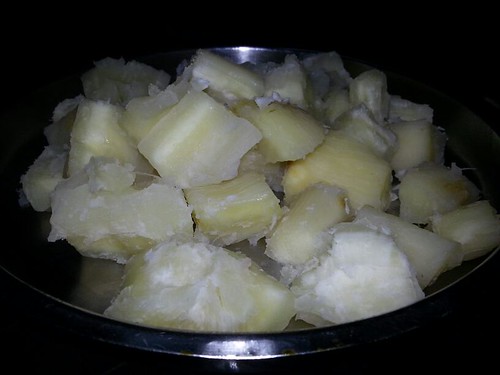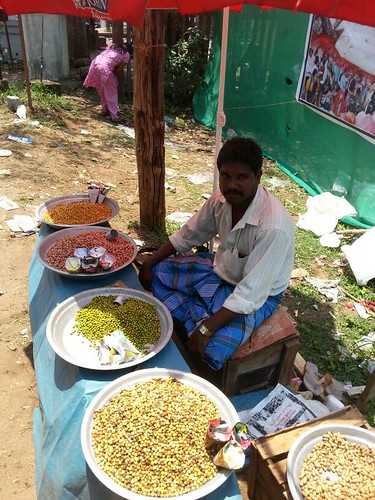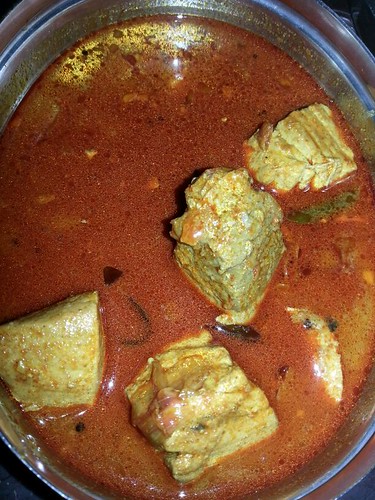Glossary K
Kappa Puzhungiyathu refers to boiled or steamed cassava which is called Kappa or Kappioka in Malayalam, the language in Kerala, India.
Kappa is one of the staple food in Kerala, India. They are cooked in varieties of way and one of them is by boiling or steaming then served with Chutneys or Curriesas a substitute for rice, paricularly for breakfast.
Kappa Puzhungiyathu can also be served with sugar and newly grated coconut for those who prefer sweet breakfast.
Kappa is called Kamoteng Kahoy in the Philippines. Boiled Cassava is called Nilagang Kamoteng Kahoy.
Kappa is prepared by removing the thick skin, then sliced into bite size pieces before steaming or boiling.


Picture below is an Indian housewife in Allepey, Kerala, India, skinning and preparing the Kappa before steaming/boiling


In the Philippines, we just boil Cassava (Kamoteng Kahoy) then served ith sugar as a dip or sometimes margarine or butter and sugar. We never eat boiled Cassava with savory sauces.
Kapalandi Masala refer to fried peanuts coated with Kadalamavu (Chickpea flour) then fried in Coconut oil or simply fried peanuts in Coconut oil and curry leaves flavored with Masala powder and salt.
When bought in mobile peanut and pea shop, they can be bought with chopped fresh onion topping.
It was always a joy for me to sit down in Allepey Beach in Allepey, Kerala, India with packs of Kapalandi Masala with fresh onion toppings. Nice way to spend a quiet weekend.
Picture below is a picture of Kadalamavu coated Kapalandi Masala.

Below is a scene around Allepey, Kerala, India - peanut and peas vendor selling assorted peas and peanut flavors in the church during the Holy week and Easter celebration.

Kuchember also known as Kachumber refers to a spicy tomato, cucumber and onion relish that is a refreshing accompaniment to most Indian meals with curd or vinegar dressing.
Kuchember or Kachumber is also known in other parts of India as Charlas, Charllas or Saarlas. (please article Charlas/Charllas/Saarlas)
Pictures below is my non-spicy version of Kuchember/Kachumber which I am making when I like a refreshing salad while in my home in the Philippines or when I am in my home in Germany using Apple Cider Vinegar instead of curd and minus the chopped green bird's eye chili pepper.


Deutsch: Kwek-Kwek / Español: Kwek-Kwek / Português: Kwek-Kwek / Français: Kwek-Kwek / Italiano: Kwek-Kwek
Kwek-Kwek in the food context refers to a popular Filipino street food snack consisting of hard-boiled quail eggs that are coated in an orange-colored batter and then deep-fried until crispy. This snack is known for its distinctive bright orange appearance, which comes from the batter's coloring, often achieved with food dye or annatto powder (achuete). Kwek-Kwek is typically served with a vinegar-based dipping sauce, which may include cucumber, shallots, and chili peppers, adding a tangy and spicy contrast to the savory and slightly sweet flavor of the fried batter.
Deutsch: Gegrillte Aubergine in Kokosmilchsauce / Español: Berenjena ahumada en salsa de coco / Português: Berinjela defumada em molho de coco / Français: Aubergine fumée dans une sauce au lait de coco / Italiano: Melanzana affumicata in salsa di cocco
Kulawong Talong in the food context refers to a traditional Filipino dish made from grilled or smoked eggplant immersed in a rich coconut milk sauce. This dish is renowned for its distinctive smoky flavor, achieved by grilling the eggplant until the skin is charred, which is then peeled off to reveal the soft, tender flesh. The smoky eggplant is then cooked in a sauce made from coconut milk, often seasoned with garlic, onions, ginger, and sometimes with the addition of fermented shrimp paste (bagoong alamang) or salted fish sauce for an extra layer of flavor. Vinegar or tamarind juice can also be added to introduce a tangy note to the dish.


